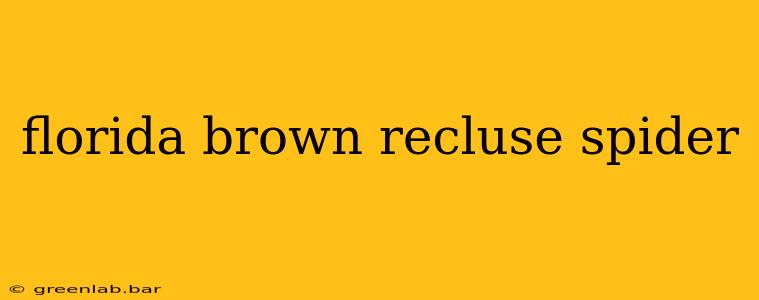The presence of venomous spiders in Florida often sparks concern, and the brown recluse is frequently cited among the most feared. However, understanding the true nature of the Loxosceles reclusa and its distribution is crucial for accurate identification and appropriate response. This comprehensive guide will delve into the specifics of the Florida brown recluse spider, addressing its identification, habitat, bite treatment, and dispelling common myths.
Identifying the Florida Brown Recluse Spider
While the brown recluse is not native to Florida, misidentification is common. Many spiders are mistakenly labeled as brown recluses due to their similar coloration and reclusive habits. True brown recluses possess several key characteristics:
-
Violin-Shaped Mark: The most distinctive feature is a dark, violin-shaped marking on the cephalothorax (the fused head and chest). The "neck" of the violin points toward the abdomen. However, this marking is not always clearly defined and can be absent in some individuals or juveniles. Relying solely on this feature can lead to misidentification.
-
Three Pairs of Eyes: Brown recluses have six eyes arranged in pairs, unlike most spiders which have eight. This is a more reliable identification characteristic than the violin marking. Requires close examination.
-
Body Size and Color: Adult brown recluses are typically ¼ to ¾ inch in body length (excluding legs). They range in color from light tan to dark brown.
-
Habitat Preferences: While they prefer dark, undisturbed spaces, their preference does not automatically confirm their species. Many other spiders share similar habitats.
Dispelling Myths: Brown Recluses in Florida
Contrary to popular belief, true brown recluses are not commonly found in Florida. While isolated instances may occur due to accidental introduction through transported goods, they haven't established a significant population. Many reported brown recluse bites in Florida are actually caused by other spider species, like the similar-looking but less dangerous southern house spider (Kukulcania hibernalis).
What Spiders in Florida Might Be Mistaken for Brown Recluses?
Several Florida spiders share similar characteristics with brown recluses, leading to misidentification. These include:
-
Southern House Spider (Kukulcania hibernalis): Often confused due to similar coloration and body shape. They are generally larger and less reclusive than brown recluses.
-
Other Cellar Spiders (Pholcidae): These long-legged spiders are often found in similar habitats and can be mistaken due to their brown coloration. However, their body structure is considerably different.
Habitat and Behavior
Brown recluses prefer dark, dry, undisturbed areas. This includes:
- Attics
- Basements
- Woodpiles
- Garages
- Storage areas
- Underneath loose debris
They are nocturnal hunters, primarily feeding on insects. They are not aggressive and bite humans only as a defensive mechanism when threatened.
Brown Recluse Spider Bite Treatment
While brown recluse bites are rarely fatal, they can cause significant local reactions. Symptoms may include:
- Pain: May be delayed for several hours after the bite.
- Swelling: Around the bite area.
- Ulceration: A characteristic lesion (sore) may develop, eventually forming a necrotic (dead tissue) area.
If you suspect a brown recluse bite:
- Clean the wound: With mild soap and water.
- Apply a cold compress: To reduce swelling and pain.
- Monitor the wound: For any signs of infection or worsening symptoms.
- Seek medical attention: If you experience severe pain, fever, or spreading infection. A doctor can properly diagnose the bite and provide appropriate treatment, potentially including antibiotics or other medications.
Conclusion
While fear of brown recluse spiders is understandable, it's crucial to accurately identify the species before reacting. In Florida, the probability of encountering a true brown recluse is low. If you are concerned about spider bites, understanding the regional spider fauna and seeking professional medical advice if necessary is paramount. Proper identification is key to obtaining accurate information about the risk and the appropriate course of action.

